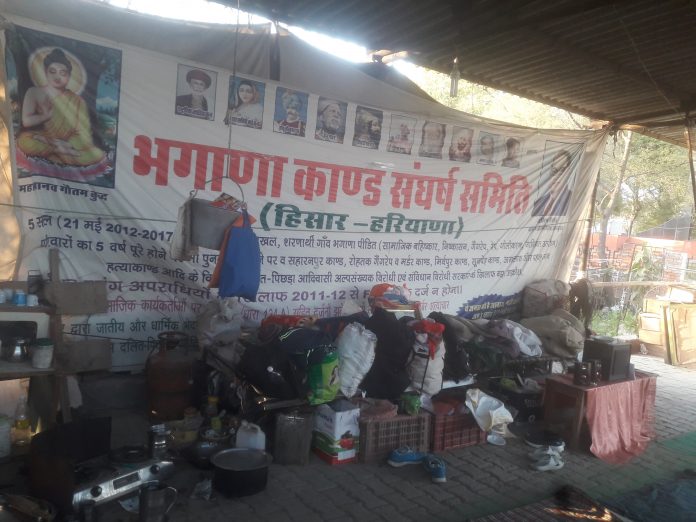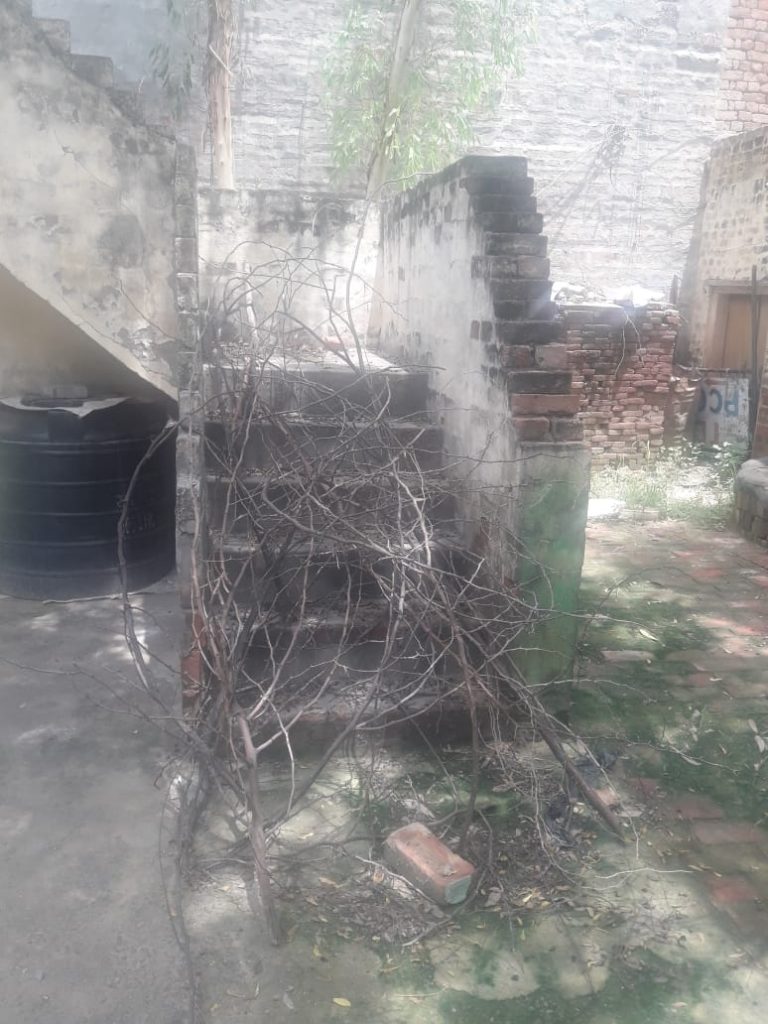With Lok Sabha elections approaching, every political party is trying to show that it cares for the marginalised communities and if voted to power, it will do all that is possible to address their concerns. However, for Dalits of Bhagana village in Haryana’s Hisar district, it seems justice will remain elusive no matter who comes to power. They have been camping outside the district secretariat for the last eight years in protest against their social boycott by the dominant Jats of their village over a land dispute but to no avail.

Dalits of Bhagana village at the protesting site in Hisar (Photo: Inder Bisht)
The boycott which resulted in the exodus of 138 Dalits families from Bhagana hasn’t seen a single prosecution till date despite several complaints and a writ-petition being filed by the victims in the Haryana High Court.
Victims’ lawyer Balwant Singh Bodia says that the state government had falsely claimed in an affidavit that all the victims have been rehabilitated to which they have filed a counter-affidavit in the court.

Dalits of Bhagana village at the protesting site in Hisar(Photo: Inder Bisht)
No relief package or any concrete steps towards the rehabilitation of the affected families have been taken by the administration till date.
In December 2012, the administration managed to persuade the protesting families to go back to the village by giving them compensation of around Rs 67,000, and an assurance of their safety.
Out of the 138 families, 51 eventually did agree to return to the village. However, later, to the shock of the families, the compensatory amount turned out to be a loan.![]()
“I still receive notices from the State Bank of India to pay my instalments for the cattle loan which the district collector had fraudulently imposed on me claiming it as a part of relief amount. I owe more than a lakh rupee to the bank now,” says Virender, a Dalit from Bhagana who had agreed to return. Many of the 51 families eventually again relocated to different parts of the state after feeling disillusioned by the promises made by the administration. along with the persistent hostile environment towards them in the village.

The playground on the disputed land in Bhagana village (Photo: Inder Bisht)
In 2014, Bhagana witnessed a second exodus of the Dhanak (a backward caste) community members when four minor girls of their community were allegedly gang-raped by the members of the Jat community.
The National Commission for Scheduled Caste (NCSC) has been monitoring the matter for the last few years, and some members of the commission have visited the village as part of their probe.
Last year, the NCSC had asked the Haryana chief secretary, director general of police (DGP) and Hisar deputy commissioner (DC) to appear before the chairman for a hearing in connection with the issue.
Satish Kajla, 39, who has been leading the protest, says that the NCSC chairman Ram Shankar Katheria had told him that the uprooted families would be relocated near Hisar. However, on the matter of prosecuting the 30-odd village members who had ordered their social boycott, Kajla says, Katheria was dismissive.

A Dalit protester from Bhagana continuing with his occupation at the protesting site in Hisar (Photo: Inder Bisht)
“He told me in private that if they were to take action against the villagers, who are jats, law and order situation in the area would suffer,” says Kajla.
“I had filed an RTI to find out any update on the SIT findings but didn’t get any response. I am clueless at the moment where the investigation is heading towards,” says a dejected Kajla.
The uprooted families camped outside Hisar’s mini secretariat and started protesting against the injustice and atrocities they were subjected to by the members of the dominant caste of their village.
“I met Congress leaders, including Rahul Gandhi, who asked me to meet the then Haryana chief minister Bhupinder Singh Hooda,” says Kajla.

Dalits of Bhagana village at the protesting site in Hisar (Photo: Inder Bisht)
The present village sarpanch Shakti Singh says that he has done his best to persuade the Dalits to return to the village but, he adds, that the “few” protesting people are keeping the issue alive for “personal gains”. “They don’t want to work but live off the compensation money. We agreed to all their demands and are willing to give them plots too,” says Shakti Singh.
The Dalits of Bhagana this correspondent spoke to said that the plots are far away from their present residences in the village and hence are of no use to them.
Despite the claims of the sarpanch that situation has normalised in Bhagana and that no social boycott of Dalits is practised anymore, few of the Dalits who had returned to the village say that the situation is not normal, particularly for the Dalits who are still protesting against the previous sarpanch and panchayat members.
Vimla Devi, 55, whose husband had expired last year says that when she along with her family returned to Bhagana after six years and went to the sarpanch for work under NREGA scheme, the sarpanch, she said, told her that since she was still part of the protest at Hisar secretariat she can’t get work.
The dispute had arisen in 2012 after the village panchayat had excommunicated some Dalits of the village for objecting to the distribution of 280 acres of the village (common) land by the panchayat members. “The village head along with the panchayat members had drawn up a scheme to divide and distribute the common land among the villagers. According to the scheme, the upper castes were to get around 1,000 square yards each while the Dalit households were getting around 100 square yards each,” says Satish Kajla.
The plan was allegedly in response to a government scheme ‘Mahatma Gandhi Malin Basti Yojana’ under which 100 square yards of a plot was to be given to every BPL (below poverty line) family.

Their abandoned houses in Bhagana village (Photo: Inder Bisht)
However, Kajla alleges that the scheme was a ruse, and the panchayat didn’t have the intention to distribute the land to the Dalits.
Out of 280 acres of common land in Bhagana, 230 is non-cultivable which is used for various purposes like playground, cremation, pond, dumping garbage and cattle dung.
The common village land was distributed in proportion to the land that the residents already owned. This meant that the Dalit families, which were mostly landless, ended up with less than 100 square yards each. They were also asked to deposit Rs 1,000 as registration fee.
“The dominant caste group in the village, most of its members belonging to one family, managed to corner most of the redistributed land,” says Kajla.
Next, the panchayat members started felling trees from the common land and sold the timber off in the market.
The actual flashpoint between the Jat-dominated panchayat and Dalits occurred when the panchayat members uprooted poles and broke off seating arrangement at a three-acre playground where the youths of the village used to play.
“We used to play on the ground daily. It was special for us because some of us had managed to clear physical round of the recruitment process because of continuous training on the ground. We were in no mood to let it go,” says Jagdish Kajla, another Dalit member of Bhagana village.
When the Dalits made a representation to the government, the Jats were angry and allegedly ordered a social and economic boycott of them.

Their abandoned houses in Bhagana village (Photo: Inder Bisht)
“The shopkeeper in the village was told not to sell to us; the common village pond was denied to our buffaloes. No one would talk to us. We were not allowed to use barber shop, village cremation ground and temples. Even using transport to travel outside of the village was not allowed to us,” recalls Satish.
“No jat would employ us in his field. The village head had stopped giving us work under NREGA scheme also,” says Satish.
Pushed to the wall the boycotted Dalits on May 21, 2012, left the village along with their cattle and camped at the premise of Hisar’s mini-secretariat. The protest has continued ever since.
Courtesy: Two Circle
